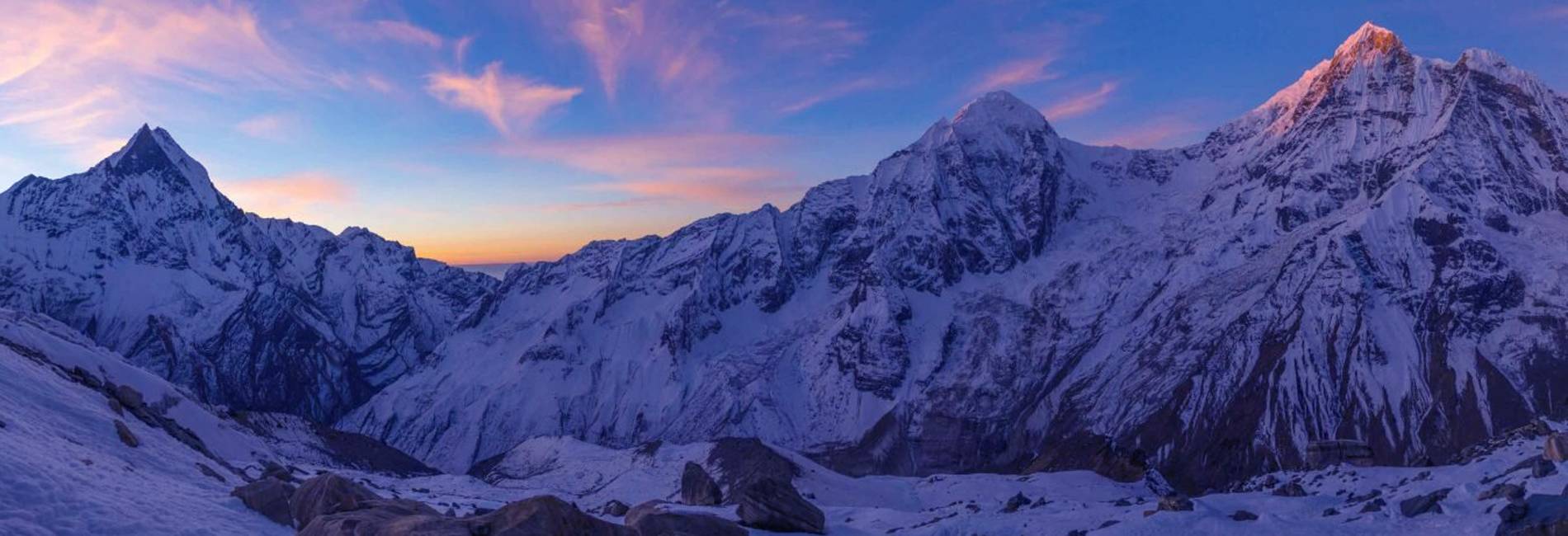Embarking on the Annapurna Base Camp trek is an immersive journey into one of Nepal’s most breathtaking landscapes, where every step reveals awe-inspiring vistas and opportunities for stunning photography. This trek, set against the backdrop of the towering Annapurna massif, offers a rich tapestry of scenery that captures the essence of the Himalayas in all its grandeur.
As you begin your trek, the initial stages through lush subtropical forests and quaint villages introduce you to the region’s vibrant culture and natural beauty. The verdant terraced fields and traditional stone houses provide striking contrasts to the ever-increasing snow-capped peaks. Photographers will find the interplay of light and shadow on these traditional structures, framed by the rising mountains, an irresistible subject.
As the trek ascends, the landscape transforms dramatically. The dense forests give way to open meadows, where wildflowers paint the terrain in vivid hues. The path gradually climbs through the Modi Khola gorge, offering increasingly panoramic views. Each turn in the trail reveals new perspectives of the Annapurna and Machapuchare peaks, often shrouded in morning mist or glowing under the golden light of sunset. These moments offer perfect opportunities to capture the ethereal beauty of the Himalayas.
Reaching the Annapurna Base Camp is a climax of visual splendor. Standing at an altitude of 4,130 meters, the base camp provides a breathtaking 360-degree view of the Annapurna sanctuary. The sheer scale of the surrounding peaks, including Annapurna I, II, III, and IV, along with the iconic Machapuchare (Fishtail Peak), is overwhelming. The snow-covered summits and the dramatic glacier formations create a stark, yet beautiful contrast against the clear blue sky. For photographers, this is a dreamscape where every frame can tell a story of raw, untamed nature.
Throughout the trek, the changing light conditions—from the soft, diffused light of dawn to the intense midday sun and the warm hues of sunset—offer a diverse range of photographic opportunities. The early morning light often bathes the mountains in a soft glow, while the clear skies and crisp air at higher altitudes bring out the sharp details of the rugged terrain. The evening skies, often ablaze with colors, add a magical quality to the already dramatic scenery.
Moreover, the cultural aspects of the trek also add depth to the photographic experience. The local Gurung and Magar communities, with their traditional attire and festivals, provide a human element that contrasts beautifully with the natural backdrop. Capturing portraits of the locals against the stunning Himalayan scenery adds an enriching dimension to your photo collection.
In essence, the Short Annapurna Base Camp trek is a photographer’s paradise, where every moment presents a chance to capture the essence of the Himalayas. From the lush lower altitudes to the towering peaks and serene base camp, the trek offers a diverse range of scenes and experiences that will leave you with a collection of photographs that tell the story of one of the world’s most spectacular trekking routes.
Introduction to Annapurna Base Camp Trek
The Annapurna Base Camp trek is renowned for its dramatic landscapes and spectacular mountain views, making it a prime destination for both avid trekkers and photography enthusiasts. Situated in Nepal’s Himalayas, this trek offers a rare combination of cultural immersion and breathtaking natural beauty. As trekkers make their way through varied terrain—from lush subtropical forests to alpine meadows—they are treated to a diverse range of scenery that includes terraced fields, traditional villages, and panoramic mountain vistas. The trek culminates at Annapurna Base Camp, situated at an elevation of 4,130 meters, where trekkers are surrounded by a stunning amphitheater of Himalayan peaks, including Annapurna I, II, III, and Machapuchare. The journey through this picturesque region provides numerous opportunities for capturing the grandeur of the Himalayas, with each stage of the trek offering unique photographic subjects and settings.
Preparing for Your Photography Experience
To fully capture the Annapurna Base Camp trek’s stunning scenery, preparation is key. Start by ensuring you have the right equipment: a versatile camera with a range of lenses, such as a wide-angle lens for landscapes and a telephoto lens for distant peaks, will enhance your ability to capture the diverse scenes along the trek. A sturdy tripod is essential for shooting in low-light conditions or capturing long exposures of the star-filled Himalayan sky. Additionally, packing extra batteries and memory cards is crucial, as the cold temperatures at higher altitudes can drain batteries quickly. Familiarize yourself with the basics of outdoor photography, including techniques for handling changing light conditions and managing the high-altitude environment. It’s also helpful to plan your shots and research the best viewpoints along the trek to make the most of your photography experience.
Best Seasons for Capturing Stunning Scenery
The best seasons for capturing the Annapurna Base Camp trek’s stunning scenery are the pre-monsoon spring (March to May) and post-monsoon autumn (September to November). During these periods, the weather conditions are generally stable, offering clear skies and excellent visibility of the Himalayan peaks. Spring is characterized by blooming rhododendron forests and lush green landscapes, providing vibrant colors and contrast against the snow-capped mountains. Autumn, on the other hand, offers crisp, clear air and stunning autumnal hues, with the possibility of capturing dramatic sunsets and sunrises over the snow-covered peaks. Both seasons avoid the monsoon rains and harsh winter conditions, which can obscure views and make trekking more challenging. Choosing the right season ensures optimal lighting and weather conditions, enhancing the quality of your photographs.
Iconic Landscape Highlights along the Trek
The Annapurna Base Camp trek features several iconic landscape highlights that are perfect for photography. The journey begins with the terraced fields and traditional villages around Pokhara, providing charming rural scenes. As the trek progresses, the trail passes through lush forests of oak and rhododendron, with seasonal wildflowers adding vibrant colors to your shots. The Modi Khola gorge and its cascading waterfalls offer dynamic compositions, while the high-altitude meadows present expansive views of the surrounding peaks. Key highlights include the Machapuchare Base Camp, where the iconic Fishtail Peak dominates the skyline, and the Annapurna Base Camp itself, surrounded by a dramatic amphitheater of mountains. Each of these locations offers unique perspectives and photographic opportunities, capturing the essence of the Annapurna region’s diverse and majestic landscapes.
Capturing the Majesty of Annapurna Mountain Range
Capturing the majesty of the Annapurna mountain range requires careful consideration of timing and technique. The Annapurna massif, including peaks like Annapurna I, II, III, and the distinctive Machapuchare, presents a formidable and awe-inspiring sight. For the best results, plan to shoot during the early morning or late afternoon when the light is soft and the peaks are illuminated by the warm hues of sunrise or sunset. This lighting enhances the textures and contours of the mountains, creating dramatic and captivating images. Use a wide-angle lens to capture the full scale of the mountain range and a telephoto lens to highlight specific peaks or details. Pay attention to the composition, incorporating elements like foreground features or clouds to add depth and interest. Capturing the Annapurna range in all its glory requires patience and an eye for detail, but the resulting photographs will vividly convey the grandeur of one of the world’s most impressive mountain ranges.
Techniques for Landscape Photography
Landscape photography along the Annapurna Base Camp trek presents a unique set of challenges and opportunities. To capture the majestic beauty of the Himalayas, mastering a few essential techniques can make a significant difference. Start by focusing on composition; the rule of thirds can help create balanced and engaging images by placing key elements off-center. Use leading lines, such as trails or rivers, to draw the viewer’s eye into the frame and toward the main subject. A wide-angle lens is particularly useful for capturing the vast landscapes and expansive mountain views. Consider using a tripod to stabilize your camera for long exposures, especially during low-light conditions like dawn or dusk. When shooting in bright sunlight, use a polarizing filter to reduce glare and enhance the colors of the sky and foliage. Additionally, experimenting with different focal lengths can help capture both sweeping vistas and intricate details of the natural environment. Patience is crucial; wait for the right lighting conditions, as the play of light and shadow can dramatically transform the landscape. By employing these techniques, you can effectively convey the grandeur and serenity of the Annapurna region’s landscapes.
Choosing the Right Equipment for the Trek
Selecting the right equipment for photographing the Annapurna Base Camp trek involves balancing functionality with portability. A versatile camera, such as a DSLR or mirrorless model, is ideal for capturing high-quality images in varying conditions. Pair it with a range of lenses, including a wide-angle lens for sweeping landscapes and a telephoto lens for distant peaks or wildlife. A sturdy tripod is essential for stability, particularly for low-light photography and long exposures. Ensure you carry extra batteries, as cold temperatures at higher altitudes can deplete them quickly, and ample memory cards to store your photos. A weather-resistant camera bag will protect your gear from rain, dust, and the elements. Consider bringing a lens cleaning kit to address dust or moisture that might accumulate. Lightweight and compact equipment is preferable, given the trek’s demanding nature, so prioritize gear that is both functional and manageable. By carefully selecting and preparing your equipment, you’ll be well-equipped to capture the stunning scenery of the Annapurna region.
Wildlife Photography Opportunities on the Trail
The Annapurna Base Camp trek offers diverse wildlife photography opportunities, providing a chance to capture the region’s unique fauna. As you trek through varied ecosystems, you may encounter species such as the Himalayan tahr, a wild goat known for its impressive horns and agility on steep slopes. The trek’s forests and meadows are also home to various bird species, including the colorful Danphe, or Himalayan monal, which is Nepal’s national bird. Early mornings and late afternoons are the best times for spotting wildlife when animals are most active. Employ a telephoto lens to capture close-up shots from a distance, minimizing disturbance to the animals. Patience is key; wildlife often requires waiting for the right moment to appear naturally in the frame. Respect the animals’ space and avoid any actions that might cause stress or disruption. By remaining observant and prepared, you can photograph the fascinating wildlife that inhabits the Annapurna region, adding a unique dimension to your trek experience.
Cultural Photography: Local Villages and People
Cultural photography along the ABC trek provides a rich opportunity to document the daily lives and traditions of local communities. The trek passes through several traditional villages, such as Ghandruk and Chhomrong, where you can capture the essence of local life. Engage with villagers respectfully and ask for permission before photographing individuals, especially in culturally sensitive areas. The vibrant attire of the local Gurung and Magar people, often adorned with intricate jewelry and colorful garments, makes for compelling portrait subjects. Capture daily activities, such as farming, weaving, and traditional rituals, to convey the cultural richness of the region. Pay attention to the architectural details of local homes and temples, which often feature unique designs and craftsmanship. Early mornings or late afternoons provide the best lighting for cultural scenes, with the soft, warm light enhancing the textures and colors of traditional clothing and village life. By immersing yourself in the local culture and approaching photography with sensitivity, you can create a meaningful and respectful visual narrative of the people and their way of life.
Sunrise and Sunset Photography Locations
Capturing the Annapurna Base Camp trek’s sunrise and sunset moments can yield some of the most breathtaking photographs of the journey. Sunrise is best experienced at locations like Poon Hill, a popular vantage point offering panoramic views of the Annapurna and Dhaulagiri ranges bathed in the early morning light. Arriving before dawn allows you to set up your equipment and prepare for the stunning transition from darkness to the first light, highlighting the snow-capped peaks in a soft, golden glow. Sunset photography is equally spectacular at Annapurna Base Camp, where the setting sun casts a warm, orange light over the towering peaks, creating dramatic shadows and highlighting the rugged terrain. The changing colors of the sky and the interplay of light on the mountains offer dynamic compositions. For both sunrise and sunset shots, use a tripod for stability and long exposures to capture the full range of colors and details. By choosing these prime locations and timing your photography sessions effectively, you can capture the sublime beauty of the Himalayas as it transforms under the magical light of dawn and dusk.
Tips for Photographing Alpine Flora and Fauna
Photographing alpine flora and fauna on the Annapurna Base Camp trek 7 Days presents unique opportunities to capture the delicate beauty of high-altitude ecosystems. When photographing alpine flora, such as the vibrant rhododendrons and edelweiss, focus on using a macro lens to capture fine details and textures. Early morning light is ideal for showcasing the delicate features of flowers while avoiding harsh shadows. For fauna, such as the elusive Himalayan tahr or the colorful Danphe, a telephoto lens is crucial for maintaining a respectful distance while still capturing detailed shots. Patience is key when photographing wildlife; observe their behavior and wait for natural moments rather than attempting to force a shot. Use a fast shutter speed to freeze motion, particularly for active animals. The cool, crisp air at high altitudes can lead to condensation on your lens, so carry a lens cloth and keep your camera gear protected. Respect wildlife and their habitats by minimizing disturbance and avoiding any actions that could cause stress. By following these tips, you can effectively capture the intricate beauty and behavior of alpine flora and fauna, contributing to a rich and diverse photo collection.
Managing Lighting Conditions during the Trek
Managing lighting conditions is crucial for capturing high-quality photographs on the Annapurna Base Camp trek, where the light can change rapidly due to the high altitude and mountainous terrain. Early mornings and late afternoons are the best times for photography, as the soft, golden light enhances the landscape and adds depth to your images. During midday, the harsh overhead sun can create strong shadows and contrast, which can be mitigated by using a polarizing filter to reduce glare and enhance colors. When photographing in low light, such as at dawn or dusk, a tripod is essential for stability and long exposures. Be mindful of the changing weather conditions; clouds can create dramatic lighting effects but can also obscure your subject. Adjust your camera settings accordingly, using a higher ISO to handle low light or a faster shutter speed to capture moving subjects. By staying adaptable and understanding how to work with varying light conditions, you can effectively manage and enhance your photographic opportunities throughout the trek.
Post-Trek Photo Editing Tips
Post-trek photo editing is an essential step in refining and enhancing the images captured during your Annapurna Base Camp adventure. Begin by organizing your photos, selecting the best shots, and discarding duplicates or less successful images. Use photo editing software to adjust basic settings such as exposure, contrast, and white balance to correct any issues caused by lighting conditions. Cropping can help improve composition and focus on key elements of the image. For landscape shots, enhance details and textures by adjusting clarity and sharpening. Use the software’s color correction tools to bring out the vibrancy of the natural scenery and ensure accurate color representation. Be cautious with saturation and sharpening to avoid unnatural effects. If desired, apply filters or presets that complement the mood of the trek but avoid over-editing. Finally, consider creating a backup of your edited photos and saving them in high-resolution formats to preserve the quality of your images. Effective post-trek editing can transform your raw captures into polished, memorable representations of your Himalayan journey.
Creating a Photo Journal of Your Experience
Creating a photo journal of your Annapurna Base Camp trek is a wonderful way to document and share your adventure. Start by organizing your photos chronologically, pairing them with personal reflections, observations, and experiences from each stage of the trek. Consider including details about the locations, such as the names of villages, key landmarks, and the significance of certain views or moments. Use a photo editing tool to create a visually appealing layout, incorporating captions or short stories that provide context and enrich the visual narrative. You can opt for a physical photo book or a digital format, depending on your preference. Including maps, sketches, or quotes can further enhance the journal and make it more engaging. Additionally, integrating elements such as wildlife encounters or cultural interactions adds depth to the journal, making it a comprehensive and personal keepsake of your trek. By combining visual and written elements, you create a meaningful record of your journey that captures the essence of your experience in the Annapurna region.
Conclusion: Immortalizing Your Journey through Photography
Immortalizing your Annapurna Base Camp trek through photography is a rewarding way to preserve and share the memories of your adventure. By applying thoughtful techniques, selecting the right equipment, and managing lighting conditions, you can capture the stunning landscapes, vibrant flora, and dynamic wildlife of the Himalayas. Effective post-trek editing and creating a photo journal further enhance your ability to convey the essence of your journey, blending visual storytelling with personal reflections. Photography not only documents your trek but also enables you to relive and share the beauty and significance of your experience. Each photograph becomes a testament to the remarkable sights and moments encountered along the trail, providing a lasting reminder of your journey through one of the world’s most spectacular mountain regions. Embracing the art of photography enriches your trek and helps you celebrate and cherish the adventure for years to come.







